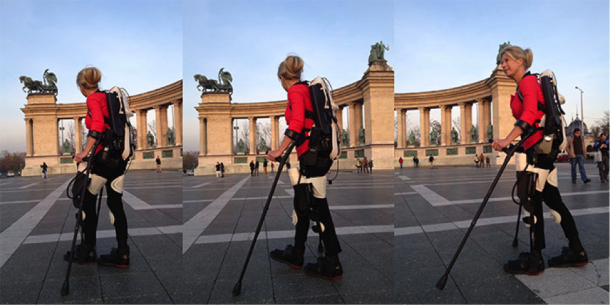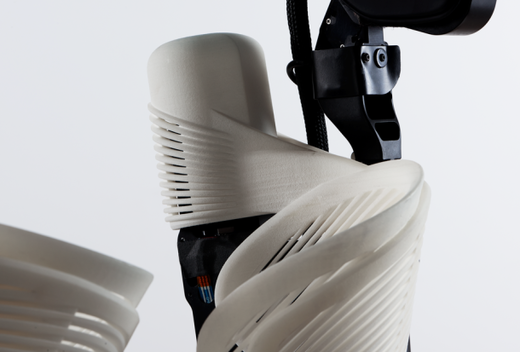The robotic suit, created by 3D Systems and EksoBionics, allows Amanda Boxtel, who was paralyzed in a skiing accident, to walk for the first time since 1992.
© 3D Systems
Amanda Boxtel's doctors told her she'd never walk again. But her new 3D-printed exoskeleton says otherwise.
In 1992, Boxtel was paralyzed from the waist down in a catastrophic skiing accident. But 22 years later, thanks to a groundbreaking 3D-printed robotic suit developed by 3D Systems and EksoBionics, she's able to stand up and move around on her own.
Boxtel's new exoskeleton, the first of its kind, was custom-built for her. Designers from 3D Systems scanned her body, digitizing the contours of her spine, thighs, and shins, a process that helped them mold the robotic suit to her. Then they combined the suit with a set of mechanical actuators and controls made by EksoBionics. The result, said 3D Systems, is the first-ever "bespoke" exoskeleton.

© 3D SystemsA closeup of the 3D printed exoskeleton.
According to
Scott Summit, the senior director for functional design at 3D Systems, the partnership between the two companies was about coming up with a way to fit the exoskeleton to Boxtel's body in such a way that it never had hard parts bumping into "bony prominences," such as the knob on the wrist.
Such body parts "don't want a hard surface touching them," Summit explained. "We had to be very specific with the design so we never had 3D-printed parts bumping into bony prominences, which can lead to abrasions" and bruising.
One problem that the designers faced in this case was that a paralyzed person like Boxtel often can't know that bruising is happening because she can't feel it. That's dangerous, Summit said, because undetected bruises or abrasions can become infected. "So we had to be very careful with creating geometry that would dodge the parts of the body that it had to dodge...[designing] parts that wouldn't impede circulation or cause bruising."
In addition, because 3D-printing allows the creation of very fine details, Boxtel's suit was designed to allow her skin to breathe, meaning she can walk around without sweating too much.
The process of creating the 3D-printed robotic suit lasted about three months, Summit said, starting when he and 3D Systems CEO Avi Reichenthal met Boxtel during a visit to EksoBionics. Boxtel is one of ten EksoBionics "test pilots" and Reichenthal was inspired by her vision of what might be done with her new exoskeleton.
Already, Summit said, the exoskeleton was designed to attach to the body very loosely with Velcro straps, with an adjustable fit. But it wasn't meant for any one person.
That's where 3D Systems came into play. By using a special
3D scanning system, Summit's team was able to create the custom underlying geometry they used in making the parts that attach to the exoskeleton. "When the robot becomes the enabling device to take every step for the rest of your life," Summit said of Boxtel and her exoskeleton, "the connection between the body and the robot is everything. So our goal is to enhance the quality of that connection so the robot becomes more symbiotic."


Reader Comments
to our Newsletter